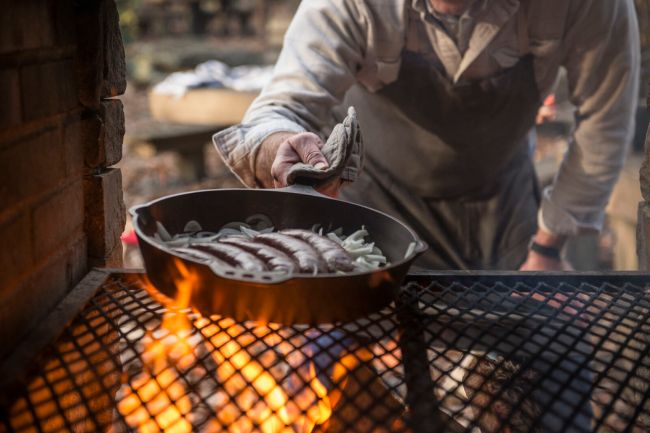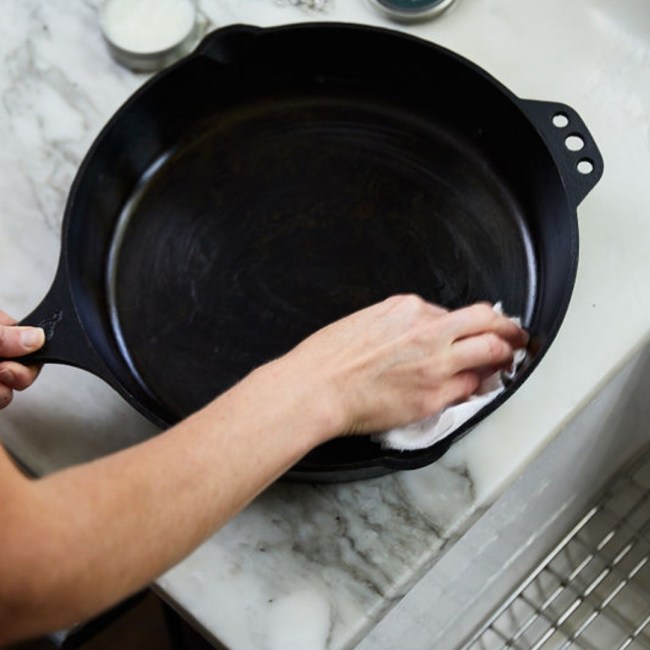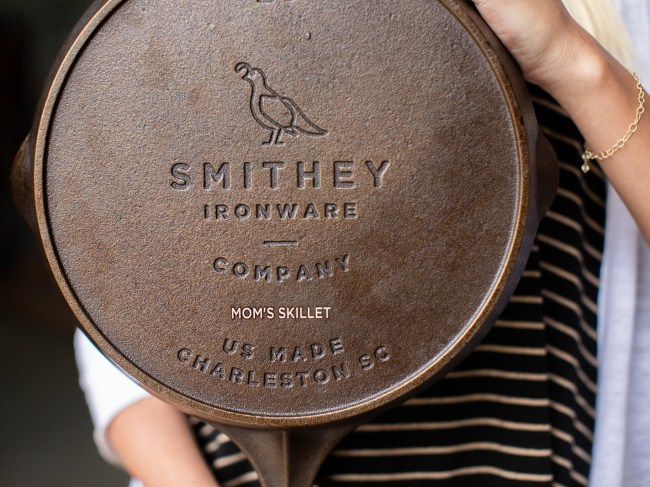
via Smithey Ironworks
A couple of weeks ago, I was texting with my grandma about pots and pans. I told her about a new set of stainless steel pots and pans I bought myself, replacing a cheap non-stick set I bought (and eventually, ruined) after I first moved to Los Angeles. I already had a trusted cast iron skillet, but I was over the moon for how my first good set of cookware would elevate my cooking game.
Then she told me about her set: A treasured wedding present on the day she married my grandfather, 66 years ago.
She still uses them almost every day, knowing all their quirks on a hot stove like the back of her hand.
That stuck with me. Great cookware is timeless. It’s an intimate tool in our daily lives, especially considering its core function: Preparing the meals that nourish us and the ones we love for decades.
Unlike consumer electronics, smartphones, or other gizmos with planned systemic obsolescence, quality cookware is engineered for generations. Sure, the term “lifetime guarantee” gets thrown around a lot, but how many things can you say you own that were made to last for life and get as much use as your cookware?
That’s one of the reasons why cast iron has exploded in popularity in the last decade. Using message boards and social media, pockets of cast iron enthusiasts started seeking out the pots and pans in the 1800s, then restoring them and bringing them back to life. Part of the thrill was the hunt of finding them in an antique store or flea market, then restoring them, seasoning them, and cooking with them as intended.
Then a handful of companies popped up, working with proper iron foundries in the United States to produce cookware that’s awfully similar to what the pioneers took on the Oregon Trail.
—
This is how Isaac Morton, the Charleston-based founder of Smithey Ironware Company, became obsessed with cast iron cookware.
“I didn’t plan to start a brand or cookware company,” Isaac tells me on a phone call. “I collected old cast iron cookware. May 15 years ago, my sister-in-law gave me an old Griswold pan. I really liked it a lot.”
“Up until that point, I was actually a little fearful of cast iron,” says Isaac. “I didn’t totally understand it. People raved about cast iron, but I didn’t know much about it or actually knew about it. I wasn’t sold on it because it always seemed like food stuck to it and everything was rough and porous, and it had a sort of sandpaper-like surface.”
He continues.
“She gave me this pan, which was a 10 or eight-inch Griswold. Griswold, as a company, existed from 1880 to probably 1960 and made cast iron cookware. They made a vintage style with a really smooth surface with some design elements that make the pan interesting to look at and functional.”
“I went deep down a rabbit hole learning about cast iron from this one piece of cast iron that my sister-in-law gave me. I started collecting old pieces, buying them at flea markets, buying them on eBay, refinishing them basically in my backyard. I would give old pans to friends and family and they really enjoyed them. It was a hobby for me.”

via Smithey Ironwork
“I saw the price of vintage cast irons start to get a little more expensive. And I did a little research. I was in a career transition at the time and I thought, ‘Well, maybe I’ll give this a go. I’ll see what it takes to design a piece and try to figure out how to create cast iron with a smooth, polished surface.’
“And so I did that. I failed a bunch of times trying to figure it out, but eventually got to create what was our first piece, which is a 10-inch cast iron skillet – what we call a traditional skillet now, with a traditional shape.”
“That was about seven years ago, maybe eight, seven and a half years ago. Since then, we have added more pans over time, learned a lot, and added people to the business. Now, yeah, we’ve got a full fledged cookware brand, cast iron cookware brand. It’s been a learning experience, but a lot of fun too.”
Why does cast iron cookware have so much mystique?
Cast iron is game-changer for your cooking game. There’s nothing like using a Smithey Cast Iron skillet to get a serious sear on rib-eye or piece of fish. I’ve used my cast iron for pretty much everything, from crispy lemon garlic chicken thighs to savory skillet breakfast potatoes.
There’s just something about how cast iron cookware conducts heat and enhances flavor, which makes it a pleasure to cook on. It works on pretty much all cooking surfaces – gas, induction, electric, the grill, campfire coals, an oven. You name it, you can pretty much cook on it with cast iron. Once you build up a good season, you’ll throw your non-stick pans in the trash for good.
Because it’s so beloved by chirpy evangelists like myself, cast iron is steeped in mythology and lore. It’s been used as a cooking apparatus for centuries, which is perhaps why it continues to have so much folksy appeal. In a digital world of precision and convenience, cast iron cooking feels like cooking the old-fashioned way, just like our immigrant ancestors did.
In some ways, it feels part of an identity. It’s culinary heritage.
“Cast iron is definitely ruggedly American, although cast iron has been around for thousands of years,” Isaac tells me. “Every region, whether in the West, the South, the Northeast, or California, everyone believes that cast iron is a part of their local heritage in some way, and they’re right in some respects. But really, when it comes to cast iron in the United States, its roots are primarily in the Rust Belt where a lot of our foundries traditionally were located.”
“There were some foundries in the South that poured cast iron as well. But we have this vision of people rolling across the prairie with cast iron on their carriage horses, and this kind of manifest destiny idea, which is true. But it’s funny that every region, no matter who you talk to… They all think of cast iron as if it’s close to their region demographically.”
As cast iron has become more and more popular in American kitchens of all shapes and sizes, the material has been memed to death – mostly out of endearment. But also out a lot of good-natured ribbing around the laundry list of dos and don’ts that come with cast iron care.

More on that below.
“Out of any piece of cookware that you have in your kitchen,” Isaac explains. “Cast iron tends to be the closest possession – a sort of protected possession. That’s because you care for it more than you need to care for other pieces of cookware. You have a connection with it. It’s almost like your pet or your car or your garden – you take a lot of pride in it. When people have things that they care for and they want to care for and have a history with, they take real possession of it. There’s a psychological connection with cast iron cookware that most other cookware doesn’t have.”
Busting some myths and misconceptions of cast iron cookware
“There’s a lot of mythology built up over cast iron,” Isaac tells me.
There are all kinds of myths about cast iron: You can’t cook acidic foods in cast iron, that you can only use it for slow cooking, that food will always stick in cast iron. I asked Isaac about how some myths and misconceptions they usually have to address with customers at Smithey Ironware.
Without a surprise, soap is the biggest flag raised.
“One of the biggest is whether to use soap or not,” says Issac.
“And the myth that you shouldn’t use soap originates because soap used to have a lot more caustic lye,” he explains. “There was more lye in soap years ago than there is today and lye has a tendency and to break down seasoning. So the myth that carried forward was that if you wash your cast iron with soap that you’ll be ruining all the seasoning that you’ve put so much work into creating. And because soap doesn’t have quite as much lye today, or in some cases no lye, soap is fine. I use a little bit of soap. I don’t use a lot of soap, but you can, and it doesn’t hurt your pan as long as you dry it, clean it, dry it, dry it on the range, put a little bit of oil on it.”

Regarding oil, Isaac elaborates.
“It doesn’t matter what kind of oil is on the surface after you’ve cooked with it – that will keep it in good condition. Basically, you put oil on the surface and then you just wipe that oil off, so you’ve got a tiny, tiny sheen of oil left on the surface. But cleaning is one of the biggest myths…”
On designing heirloom cast iron cookware in the 21st century
When Isaac started his new life chapter as an entrepreneur, he envisioned Smithey Ironware Company as a modern American-made cookware brand, crafting heirloom-quality pots and pans.
“I sort of didn’t take no for an answer,” he tells me. “I was really determined. I knew that physically and from an engineering perspective, what we were trying to do could be done because it was done a hundred years ago. That was done with different technology, but I knew it could be done. So that being pretty stubborn, really, really stubborn, and also simultaneously, from a business perspective, being willing to know what the downside would be and trying to keep the downside if it didn’t work at something that I can be comfortable with.”
“I’m not an engineer by training, but I am kind of engineer-brained a little bit, and so I just read as much as I possibly could and asked these many questions from people that knew a lot more, or had forgotten a lot more than I do. People in the foundry industry were very helpful and people in the metal fabrication and machining world were super helpful. So it started with us hacking it together in the early years.”
“Neither of us knew what we’re doing,” he adds. “But we knew enough to know what the end goal was and that it was possible to create what we wanted.”

How is Smithey Ironware different?
Smithey Ironware prides itself on a premium look and feel. It’s heavy, like a proper cast iron skillet should be. Like the antique cookware of yesteryear, it’s a conversation-starter that upscales the aesthetic of any kitchen or outdoor grilling space. An experienced craftsperson makes each Smithey piece in South Carolina, bringing a down-home artisan touch to each skillet or pot.
Compared to the cast iron or carbon steel cookware you find in a big box store, Smithey skillets are astonishingly smooth. They’re handsomely polished, giving it a silky finish that’s a joy to cook on once you build a good seasoning.
I ask Isaac how Smithey Ironware Company stands out from competitors, like the YETI coolers of the modern cast iron cookware movement.
“We are really, really passionate about customer service, extremely passionate about customer service,” says Isaac. “And we see ourselves as teachers as much as customer service people. So, when customers have questions or need something, we’ve got people that are experts in cast iron that season thousands of pieces of cast iron right there to talk to about it.”
“That’s one of the most important things in being part of the cast iron community is being available to that community, no matter what kind of question you have about cast iron because it can be intimidating. People don’t know how to care for it in some cases, or they fear they’ve screwed it up because it’s rusty or they put it in the dishwasher.”
“But back to your point, it’s basically indestructible. And so anything you mess up, you can always redo. So that’s what we do. Our whole team here when we talk to customers, whether it’s chatting or over the phone or over email, on a blog or on our website, trying to stay engaged and be good teachers.”
I also asked Isaac about any high profile culinary personalities that are Smithey fans.
“Locally here in Charleston, Mike Lata is a big fan. Mike’s a sort of famous chef who runs FIG – a spectacular restaurant. We’ve had a lot of support from the culinary community in Charleston.”
“We got a nice shout out randomly from Alton Brown a couple weeks ago, which was kind of, which was gratifying. He purchased one of our pans – our 11-inch deep skillet – and said it was the best piece of cast iron he’d ever cooked on, so that was great. It’s always nice to see genuine support like that,” says Isaac.
Smithey Carbon Steel Cookware

via Smithey Ironworks
A couple years ago, Smithey debuted a handsome new weapon in their cookware arsenal: a carbon steel “farmhouse” skillet”, inspired by authentic American blacksmith designs of the 18th and 19th centuries. Lighter than cast iron, a blacksmith hand forges each Smithey farmhouse skillet at a shop in Charleston.
“I think carbon steel is some of the coolest stuff,” Isaac tells me. “And I think I love it because we’ve collaborated with a blacksmith shop here locally that is our neighbor. We’ve had a lot of fun creating what is truly, totally handmade piece of cookware. So our carbon steel is a thinner-gauged metal, so it’s a little lighter. It wouldn’t be lighter if it were as thick as cast iron, but by virtue of being thinner, it is lighter, so it’s more maneuverable.
Think of each pan like a snowflake – completely different.
“Each piece is also completely different from the one made before it. They truly are handmade. They’re forged, which is a different process. Forging is a process where you bend or hammer metal into form. Casting is the process of pouring molten metal into a mold, and then it freezes into form. So, there are some subtle differences,” he explains.
“But carbon steel and cast iron are both different varieties of iron, an iron-based metal. So they tend to react similarly to heat. If you’re searing a piece of fish, if you’re searing a steak, you’re going to get a similar performance.
“Cast irons probably will hold a little more heat and absorb a little more heat by virtue of just having more mass, but they’re similar materials,” says Isaac. “They take seasoning in a very similar way. We have more flexibility with carbon steel to make, create different shapes than with cast iron. So, the shapes that we make in carbon steel – we’ve have oval, we have interesting handles. We’ve got hand-formed ridges on the pan. So there’s some ornamental, interesting stuff on our carbon steel line that’s really fun.”
—
The world of great cookware is a world of conviction and passion. It’s a highly addictive rabbit hole where armchair enthusiasts with scratch cooking experience can come to appreciate the craftsmanship of a trade like ironwork. All the while, learning that sometimes a cooking tool is more than just a tool when it takes your cooking or grilling game to a new level.
After all… who doesn’t like to eat?
“I’m biased ’cause I’m more of a griller, and so I tend to follow what people say about our cast iron when it’s on the grill,” Isaac tells me. “That’s an area that I really enjoy. I love cooking outside. I like cooking over fire. I think those outdoor cooks tend to be the most passionate, at least from my perspective. We’ve got a little showroom out here in Charleston and I hear all day sort of people’s different perspectives. We have high-end foodies come in that have a totally different way of interacting with our cookware. But then we have the backyard barbecue guy as well.”
“The common thread is that people they love to cook, one, and appreciate something well-made. Those two bonds bring a lot of different correlation between different types of chefs and home cooks.”